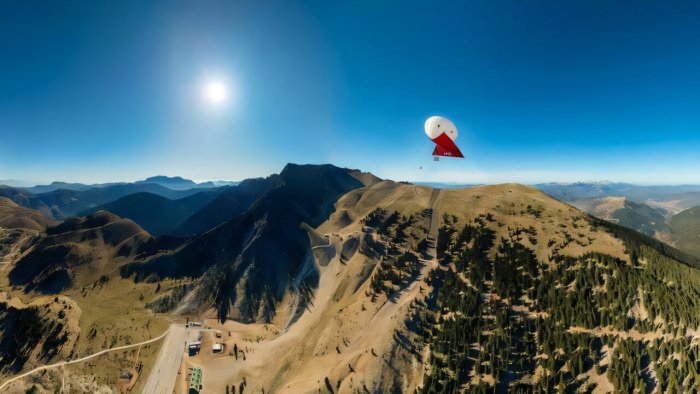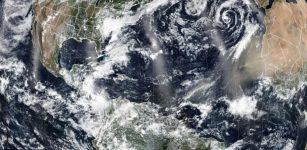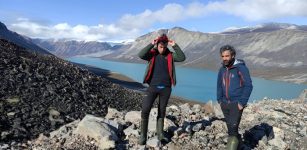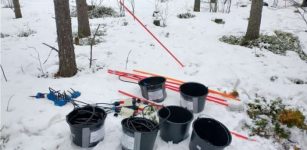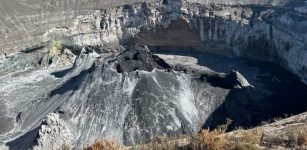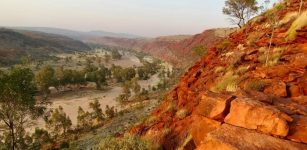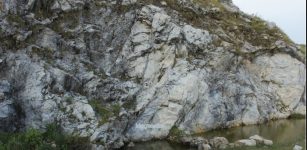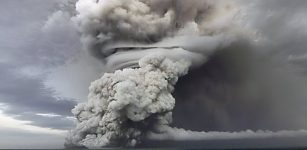A Greek Mountain May Help Solve The Mystery Of Cloud Formation
Eddie Gonzales Jr. – MessageToEagle.com – On the rocky slopes high above lush pine forests and mountain lakes, a group of researchers has just finished setting up their gear.
The view from the top of Mount Helmos where the researchers have placed their instruments. Credit: Aarhus University
Even though the weather at sea level is a comfortable 21 degrees, the researchers need their warm clothes. The temperature rarely climbs above 10 degrees at the top this time of the year.
The mountain is Mt. Helmos on the Greek island of Peloponnese. The rocky peak is already home to an observatory, but in the last couple of weeks new scientific equipment has started claiming more and more space up there.
What the researchers hope to do is solve the mystery of cloud formation and changes in cloud properties. In the quest to better understand how the climate of the Earth works and is shaped by humans, knowing exactly how clouds are formed and respond to human activities are essential.
But to this day, a lot of details about clouds are unknown, explains Ulas Im, senior researcher at the Department of Environmental Science at Aarhus University, and the coordinator of the project.
“Understanding cloud formation is essential to make projections like the one thousands of scientists create every five to seven years, when a new IPCC report comes out. Clouds are the biggest uncertainty of the climate projections in these reports. That is why we are trying to better understand them,” he says.
Together with colleagues from all over Europe, Ulas Im is in the center of a giant research project called Clean Cloud. The idea is to learn more on how clouds and particles in the atmosphere interact, using ground-based and satellite observations, laboratory experiments and models.
To do this, large field experiments are planned in the European climate hotspots: The Arctic and the Mediterranean.
“We’ve finished our experiments in northern Greenland and now we are shifting our focus to the Mediterranean with field experiments in Greece. The Arctic and the Mediterranean are the two regions in Europe most affected by climate change. By studying clouds in these areas, we hope to better predict future climate changes,” Ulas Im says.
A big international project
The research project is called Clean Cloud and is a collaboration with researchers from 20 institutions in 12 European countries.
The researchers aim to obtain new knowledge about cloud formation and their interactions with particles during the next four years.
Enveloped in clouds all winter
There’s a reason Ulas Im and his colleagues chose Mt. Helmos. During the winter, the mountain is enveloped in clouds most of the time, and this enables the researchers to study the cloud from within.
“Most research on clouds has been done from below or from airplanes or satellites above. We hope that this unique approach will provide us with more extensive knowledge on the inner workings of clouds,” Ulas Im says.
In 2021, a smaller field research campaign took place on Mt. Helmos. The data from those experiments was quite encouraging and that is why the researchers are doing an even bigger project up there.
“Back in 2021, there were fewer instruments, and the campaign only lasted a few weeks. Now we are back with much more gear and ready to do a long-lasting experiment,” he says.
The plan is for the expensive instruments to stay on the mountain top until spring. To do this, many researchers need to look after the equipment on a regular basis. And that is expensive.
“We are part of a large … project, and that is what makes these expensive research setups possible. But hopefully we’ll learn a lot more about clouds during the project,” he says.
No clouds without particles
The instruments on the mountain top will soon be immersed in clouds. This enables Ulas Im and his colleagues to study how small particles in the air affect cloud formation.
Because, as he explains, particles are the key to understanding clouds. Without particles like dust, pollen, bacteria and exhaust from cars and factories there would be no clouds.
“The basic idea is that you always have water vapor in the atmosphere. Dust or other particles provides a surface for the water vapor to condense on. When the water condenses on these particles, they form the cloud droplets,” he says.
But not all particles seed new clouds. Some particles change the characteristics of the clouds instead.
“Clouds have droplets that are liquid or ice. Some clouds are only liquid droplets. A large fraction of clouds is both. Mineral dust or biological particles like pollen are efficient in making ice in the clouds. Without these, the temperature required for the droplets to freeze would be much lower.
“With more ice crystals, clouds become transparent to sunlight, which then reach the Earth’s surface. However, with global warming, we move from ice to more liquid clouds. This is important because clouds with more liquid droplets reflect more of the sunlight back into space, and this could affect the temperature on Earth.”
Ulas Im and his colleagues expect that this will change in the near future, though.
“Thanks to reductions in man-made emissions due to international agreements, we expect less man-made particles in the atmosphere. This suggests that the relative importance of natural aerosols can be more important in the future, which we call post-fossil.”
“Therefore, we need to better understand and predict how this competition will work in the future.”
How people shape the clouds
Not only do the naturally occurring particles affect the clouds. Particles from human activities play a big role as well.
“Over the oceans, the ships make plumes, letting particles out. This actually changes the properties of the local clouds. The same goes with airplanes. They have a similar effect. Or large power plants that burn fossil fuels. All these change the environment locally,” Ulas Im says.
In the northernmost part of Greenland, where the first part of the project was done, very few humans come by. Some particles blow north from Europe, Russia and the US, but mostly during the winter. In the summer, the researchers mostly measure naturally occurring particles up there. That is not the case in Greece.
Dust from the Sahara combined with biological particles from European forests coupled with small particles from human activities such as industry, residential heating and the many ships and airplanes passing through the Mediterranean creates a very different chemical cocktail in the atmosphere.
“The human made particles generally have a cooling effect on the climate. But as they are emitted together with CO2, which has a warming effect and stays much longer in the atmosphere, it is still CO2 that drives climate change.”
“However, particles mask part of this warming by directly scattering solar radiation, but also indirectly by affecting the clouds. Therefore, it’s important for our climate models to accurately represent this and to understand the human impact on global warming.”
Ulas Im and his colleagues hope to publish the first research with results in a year.
Written by Eddie Gonzales Jr. – MessageToEagle.com Staff Writer

